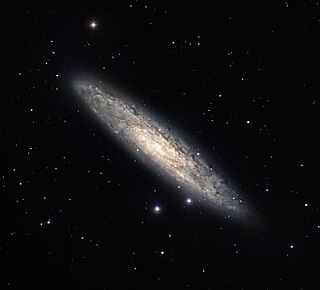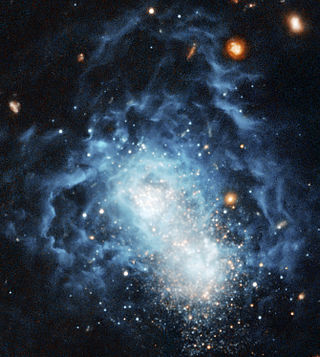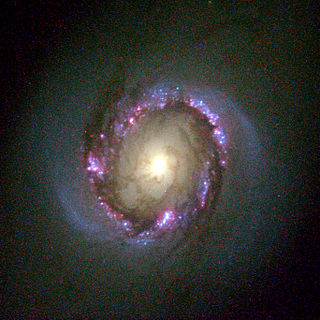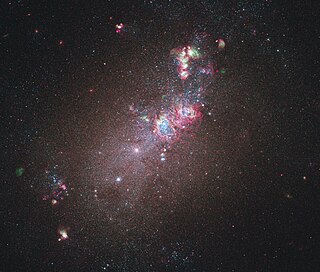
The Andromeda Galaxy is a barred spiral galaxy and is the nearest major galaxy to the Milky Way. It was originally named the Andromeda Nebula and is cataloged as Messier 31, M31, and NGC 224. Andromeda has a D25 isophotal diameter of about 46.56 kiloparsecs (152,000 light-years) and is approximately 765 kpc (2.5 million light-years) from Earth. The galaxy's name stems from the area of Earth's sky in which it appears, the constellation of Andromeda, which itself is named after the princess who was the wife of Perseus in Greek mythology.

Hoag's Object is an unusual ring galaxy in the constellation of Serpens Caput. It is named after Arthur Hoag, who discovered it in 1950 and identified it as either a planetary nebula or a peculiar galaxy. The galaxy has a D25 isophotal diameter of 45.41 kiloparsecs (148,000 light-years).

Messier 100 is a grand design intermediate spiral galaxy in the southern part of the mildly northern Coma Berenices. It is one of the brightest and largest galaxies in the Virgo Cluster and is approximately 55 million light-years from our galaxy, its diameter being 107,000 light years, and being about 60% as large. It was discovered by Pierre Méchain in 1781 and 29 days later seen again and entered by Charles Messier in his catalogue "of nebulae and star clusters". It was one of the first spiral galaxies to be discovered, and was listed as one of fourteen spiral nebulae by Lord William Parsons of Rosse in 1850. NGC 4323 and NGC 4328 are satellite galaxies of M100; the former is connected with it by a bridge of luminous matter.

A starburst galaxy is one undergoing an exceptionally high rate of star formation, as compared to the long-term average rate of star formation in the galaxy, or the star formation rate observed in most other galaxies.

Centaurus A is a galaxy in the constellation of Centaurus. It was discovered in 1826 by Scottish astronomer James Dunlop from his home in Parramatta, in New South Wales, Australia. There is considerable debate in the literature regarding the galaxy's fundamental properties such as its Hubble type and distance. It is the closest radio galaxy to Earth, as well as the closest BL Lac object, so its active galactic nucleus has been extensively studied by professional astronomers. The galaxy is also the fifth-brightest in the sky, making it an ideal amateur astronomy target. It is only visible from the southern hemisphere and low northern latitudes.

The Whirlpool Galaxy, also known as Messier 51a (M51a) or NGC 5194, is an interacting grand-design spiral galaxy with a Seyfert 2 active galactic nucleus. It lies in the constellation Canes Venatici, and was the first galaxy to be classified as a spiral galaxy. It is 7.22 megaparsecs away and 23.58 kiloparsecs (76,900 ly) in diameter.

A ring galaxy is a galaxy with a circle-like appearance. Hoag's Object, discovered by Arthur Hoag in 1950, is an example of a ring galaxy. The ring contains many massive, relatively young blue stars, which are extremely bright. The central region contains relatively little luminous matter. Some astronomers believe that ring galaxies are formed when a smaller galaxy passes through the center of a larger galaxy. Because most of a galaxy consists of empty space, this "collision" rarely results in any actual collisions between stars. However, the gravitational disruptions caused by such an event could cause a wave of star formation to move through the larger galaxy. Other astronomers think that rings are formed around some galaxies when external accretion takes place. Star formation would then take place in the accreted material because of the shocks and compressions of the accreted material.

The Sculptor Galaxy is an intermediate spiral galaxy in the constellation Sculptor. The Sculptor Galaxy is a starburst galaxy, which means that it is currently undergoing a period of intense star formation.

I Zwicky 18 is a blue compact dwarf galaxy located about 59 million light years away in the constellation Ursa Major. The galaxy was first identified by Swiss astronomer Fritz Zwicky in a 1930s photographic survey of galaxies.

The Cartwheel Galaxy (also known as ESO 350-40 or PGC 2248) is a lenticular ring galaxy about 500 million light-years away in the constellation Sculptor. It has a D25 isophotal diameter of 44.23 kiloparsecs (144,300 light-years), and a mass of about 2.9–4.8 × 109 solar masses; its outer ring has a circular velocity of 217 km/s.

NGC 1097 is a barred spiral galaxy about 45 million light years away in the constellation Fornax. It was discovered by William Herschel on 9 October 1790. It is a severely interacting galaxy with obvious tidal debris and distortions caused by interaction with the companion galaxy NGC 1097A.

NGC 4314 is a barred spiral galaxy approximately 53 million light-years away in the northern constellation of Coma Berenices. It is positioned around 3° to the north and slightly west of the star Gamma Comae Berenices and is visible in a small telescope. The galaxy was discovered by German-born astronomer William Herschel on March 13, 1785. It was labelled as peculiar by Allan Sandage in 1961 because of the unusual structure in the center of the bar. NGC 4314 is a member of the Coma I group of galaxies.

NGC 4214 is a dwarf barred irregular galaxy located around 10 million light-years away in the constellation Canes Venatici. NGC 4214 is a member of the M94 Group.

NGC 1427A, also known as ESO 358-49, or ESO 358- G 049, is an irregular galaxy in the constellation Fornax. Its distance modulus has been estimated using the globular cluster luminosity function to be 31.01 ± 0.21 which is about 52 Mly. It is the brightest dwarf irregular member of the Fornax cluster and is in the foreground of the cluster's central galaxy NGC 1399.

Arp 273 is a pair of interacting galaxies, 300 million light years away in the constellation Andromeda. It was first described in the Atlas of Peculiar Galaxies, compiled by Halton Arp in 1966. The larger of the spiral galaxies, known as UGC 1810, is about five times more massive than the smaller galaxy. It has a disc that is tidally distorted into a rose-like shape by the gravitational pull of the companion galaxy below it, known as UGC 1813. The smaller galaxy shows distinct signs of active star formation at its nucleus, and "it is thought that the smaller galaxy has actually passed through the larger one."

NGC 6217 is a barred spiral galaxy located some 67 million light years away, in the constellation Ursa Minor. It can be located with a 10 cm (4 in) or larger telescope as an 11th magnitude object about 2.5° east-northeast of the star Zeta Ursae Minoris. The galaxy is inclined by an angle of 33° to the line of sight along a position angle of 162°.

Arp 147 is an interacting pair of ring galaxies. It lies 430 million to 440 million light years away in the constellation Cetus and does not appear to be part of any significant galaxy group. The system was originally discovered in 1893 by Stephane Javelle and is listed in the Atlas of Peculiar Galaxies.

NGC 660 is a peculiar and unique polar-ring galaxy located approximately 45 million light-years from Earth in the Pisces constellation. It is the only such galaxy having, as its host, a "late-type lenticular galaxy". It was probably formed when two galaxies collided a billion years ago. However, it may have first started as a disk galaxy that captured matter from a passing galaxy. This material could have, over time, become "strung out" to form a rotating ring.

NGC 6951 is a barred spiral galaxy located in the constellation Cepheus. It is located at a distance of about 75 million light-years from Earth, which, given its apparent dimensions, means that NGC 6951 is about 100,000 light-years across. It was discovered by Jérôme Eugène Coggia in 1877 and independently by Lewis Swift in 1878.

NGC 2445 is a peculiar ring galaxy in the constellation Lynx. The galaxy lies about 200 million light years away from Earth, which means, given its apparent dimensions, that NGC 2445 is approximately 100,000 light years across. It was discovered by Édouard Stephan on January 18, 1877. The galaxy interacts with another galaxy, NGC 2444, and as a result its shape is distorted and new stars are formed.



















